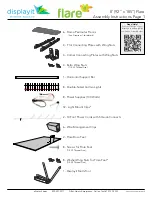
SPM Single Point Monitor
SPM Technical Handbook
3-3
14. Before securing cover to body, verify SPM will go
into Monitor Mode by powering-up the unit.
Note:
If SPM goes into Monitor Mode, proceed with
next step. If not, power down SPM, check all
cable connections and try again. If problem
persists, call Honeywell Analytics Service.
15. Power down SPM.
16. Secure cover to body (see
17. Power up unit and verify system response as
outlined in
3.5 Replacing the Fuse
SPM operation is protected with a fuse located in a fuse
holder cap (33) at the lower left front panel. The fuse size
is 5 x 20 mm slo-blo. The fuse rating may vary based
upon installed SPM options. For replacement, refer to the
fuse designation that is listed on the fuse label placed
next to the fuse holder.
Warning
Disconnect the external power source before
checking or replacing the fuse. Use only the fuse
rated for your instrument. Refer to the front
panel fuse label for the proper fuse for your
instrument.
To replace the fuse, turn the fuse holder cap (33)
counterclockwise and pull out. The fuse will remain in
the cap.
Remove the blown fuse from the cap and replace with a
new fuse of the proper rating for your instrument. Insert
fuse into fuse holder and rotate cap clockwise.
3.6 Caring for Chemcassettes
®
The SPM uses an SP (standard play-2 week), or
EP (extended play-30 day) or XP (longer life-up to
three months) Chemcassette
®
. See
Chemcassette
®
part numbers. Under normal conditions,
Chemcassettes
®
have a shelf life of approximately three
months for standard and 1 year for XP. They should
be stored in a cool atmosphere and kept out of direct
sunlight.
Most Chemcassette
®
detection systems will maintain
optimum sensitivity when stored at room temperature
(16°C to 24°C; 60°F to 75°F). A few, such as Aliphatic
Amines/Ammonia, Ammonia, Chlorine III/Oxidizers,
Diisocyanates, Hydrogen Cyanide, Hydrogen Peroxide,
Ozone, Sulfur Dioxide, and Mineral Acids must be stored
in a freezer (less than 0°C; 32°F). However, because
temperatures in storage rooms can vary, Honeywell
Analytics recommends that all Chemcassettes
®
be
stored in a freezer, except Chlorine/Chlorine Dioxide,
Chlorine/Oxidizers, Phosgene and XP Phosgene must
be stored at 4°C to 25°C (40°F to 77°F).
Each Chemcassette
®
is stamped with an expiration date
at time of manufacture. Under no circumstances should
a Chemcassette
®
be used beyond the expiration date.
Equally important, never remove a Chemcassette
®
from
its protective packaging until you are ready to install it
in your instrument. Exposure to light, ambient air, and
body oils may cause the Chemcassette
®
to lose some
of its sensitivity. For more information on Chemcassette
®
care, refer to package instructions.
Note:
Chemcassettes
®
may be ordered on a 12-month blanket
purchase order; fresh Chemcassettes
®
will be shipped
on a scheduled basis. Consult Honeywell Analytics for
details.
Summary of Contents for SPM
Page 8: ...SPM Single Point Monitor Midas Technical Handbook 1 1 1 Operation ...
Page 15: ...SPM Single Point Monitor SPM Technical Handbook 2 1 2 Installation ...
Page 20: ...SPM Single Point Monitor Midas Technical Handbook 3 1 3 Maintenance ...
Page 24: ...SPM Single Point Monitor Midas Technical Handbook 4 1 4 Specifications ...
Page 36: ...SPM Single Point Monitor SPM Technical Handbook 5 1 5 Options ...
Page 53: ...SPM Single Point Monitor SPM Technical Handbook A 1 A Bi Directional Communications Protocol ...
Page 61: ...SPM Single Point Monitor SPM Technical Handbook B 1 B Warranty Statement ...
















































